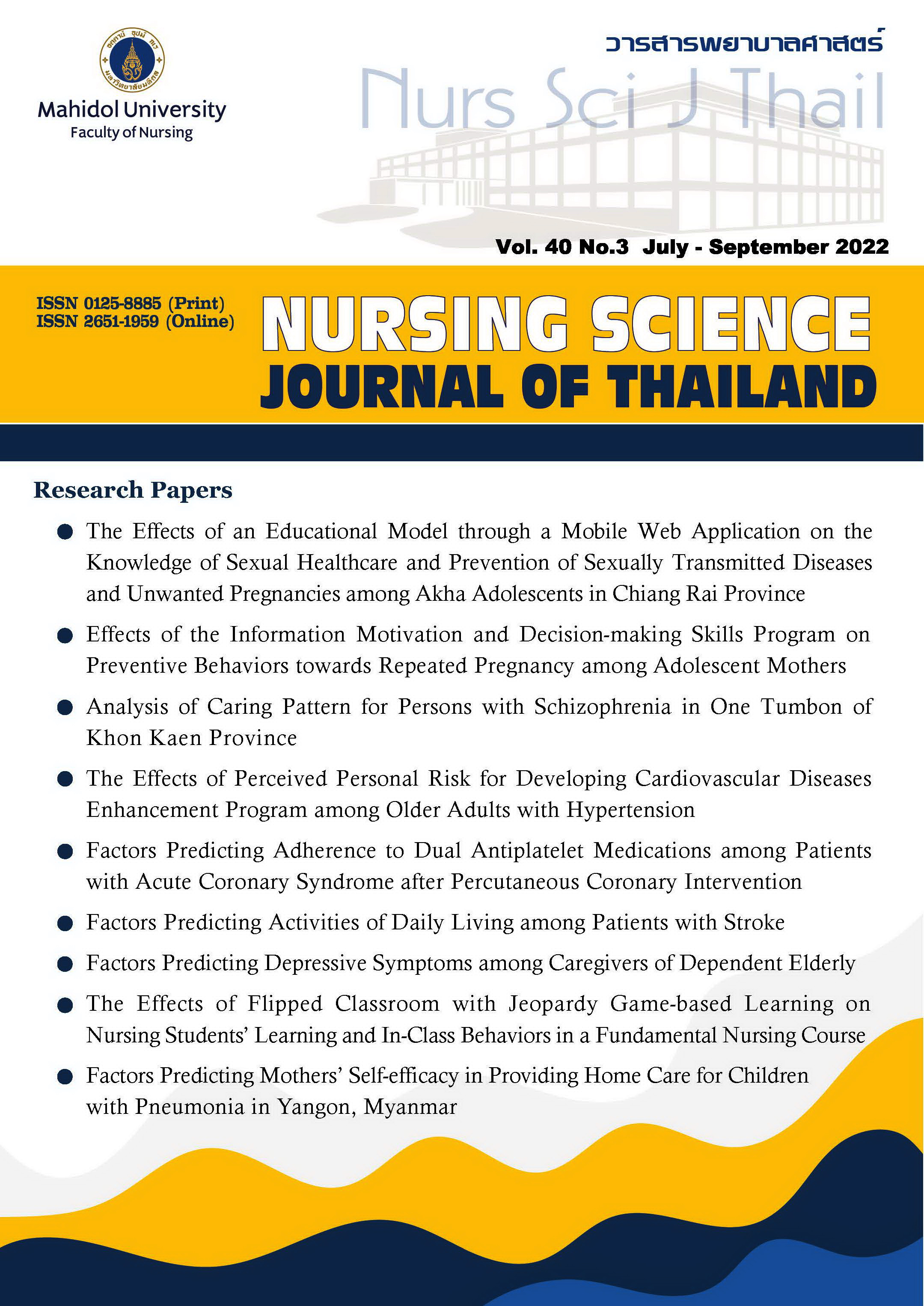ปัจจัยทำนายความสามารถในการทำกิจวัตรประจำวันของผู้ป่วยโรคหลอดเลือดสมอง
Main Article Content
บทคัดย่อ
วัตถุประสงค์: เพื่อศึกษาอำนาจการทำนายของรูปแบบบริการการฟื้นฟู การสนับสนุนการจัดการตนเอง รายได้ และภาวะโภชนาการต่อความสามารถในการทำกิจวัตรประจำวันของผู้ป่วยโรคหลอดเลือดสมอง รูปแบบการวิจัย: การวิจัยเชิงทำนาย
วิธีดำเนินการวิจัย: กลุ่มตัวอย่างจำนวน 126 ราย เป็นผู้ป่วยโรคหลอดเลือดสมองชนิดตีบตันที่มารับการติดตามการรักษาหลังจำหน่ายออกจากโรงพยาบาล ที่คลินิกอายุรกรรมระบบประสาท แผนกผู้ป่วยนอก ของโรงพยาบาลสองแห่ง เก็บรวบรวมข้อมูลโดยใช้ แบบสอบถามข้อมูลส่วนบุคคลแบบประเมินความสามารถในการทำกิจวัตรประจำวัน แบบสอบถามการสนับสนุนการจัดการตนเองและแบบประเมินภาวะโภชนาการ วิเคราะห์ข้อมูลโดยสถิตถดถอยเชิงเส้นพหุคูณ
ผลการวิจัย: กลุ่มตัวอย่างมีคะแนนความสามารถในการทำกิจวัตรประจำวันระดับมาก ( = 81.59, SD = 21.81) ภายหลังได้รับการรักษาในหอผู้ป่วยโรคหลอดเลือดสมอง กลุ่มตัวอย่างได้รับรูปแบบบริการการฟื้นฟู แบบผู้ป่วยนอกมากที่สุด (ร้อยละ 38.1) ได้รับการสนับสนุนการจัดการตนเองในระดับปานกลาง (
= 3.13, SD = 0.73) และมีภาวะทุพโภชนาการปานกลาง (
= 9.24, SD = 3.30) ปัจจัยที่ศึกษาทุกตัวร่วมอธิบายความแปรปรวนของความสามารถในการทำกิจวัตรประจำวันได้ร้อยละ 64 (R2 = .64) โดยปัจจัยด้านรูปแบบบริการการฟื้นฟู การสนับสนุนการจัดการตนเองและภาวะโภชนาการ เป็นปัจจัยทำนายอย่างมีนัยสำคัญ
สรุปและข้อเสนอแนะ: รูปแบบบริการการฟื้นฟู การสนับสนุนการจัดการตนเองและภาวะโภชนาการสามารถทำนายความสามารถในการทำกิจวัตรประจำวันของผู้ป่วยโรคหลอดเลือดสมองได้ ดังนั้นทีมสุขภาพควรมีการส่งเสริมให้ผู้ป่วยได้รับรูปแบบบริการการฟื้นฟูแต่ละรูปแบบอย่างต่อเนื่องจนกระทั่งกลับบ้าน ร่วมกับให้การสนับสนุนการจัดการตนเอง โดยเน้นให้ผู้ป่วยมีส่วนร่วมในการรักษากับทีมสุขภาพ และส่งเสริมภาวะโภชนาการโดยการคัดกรองและประเมินผู้ป่วยตั้งแต่รับการรักษาและติดตามผลอย่างต่อเนื่อง เพื่อส่งเสริมให้ผู้ป่วยโรคหลอดเลือดสมองมีความสามารถในการทำกิจวัตรประจำวันเพิ่มขึ้น
Article Details

This work is licensed under a Creative Commons Attribution-NonCommercial-NoDerivatives 4.0 International License.
ลิขสิทธิ์: วารสารพยาบาลศาสตร์เป็นเจ้าของลิขสิทธิ์ในการเผยแพร่ผลงานที่ตีพิมพ์ ห้ามผู้ใดนำบทความที่ได้รับการตีพิมพ์ในวารสารพยาบาลศาสตร์ไปเผยแพร่ในลักษณะต่างๆ ดังต่อไปนี้ การส่งบทความไปตีพิมพ์เผยแพร่ที่อื่น การนำบทความเผยแพร่ออนไลน์ การถ่ายเอกสารบทความเพื่อกิจกรรมที่ไม่ใช่การเรียนการสอน ยกเว้นเสียแต่ได้รับอนุญาตจากวารสารพยาบาลศาสตร์

Disclaimer: เนื้อหาบทความหรือข้อคิดเห็นใดๆ ในวารสารพยาบาลศาสตร์ ถือเป็นความรับผิดชอบของผู้เขียน กองบรรณาธิการไม่จำเป็นต้องเห็นด้วยและไม่มีส่วนรับผิดชอบแต่อย่างใด
References
Johnson CO, Nguyen M, Roth GA, Nichols E, Alam T, Abate D, et al. Global, regional, and national burden of stroke, 1990-2016: a systematic analysis for the Global Burden of Disease Study 2016. Lancet Neurol. 2019;18(5):439-58. doi: 10.1016/S1474-4422(19)30034-1.
World Stroke Organization. Up again after stroke [Internet]. Geneva: World stroke Organization; 2018 [cited 2019 May 4]. Available from: http://worldstrokeorganization.blogspot.com/2018/09/up-again-after-stroke.html.
Barthels D, Das H. Current advances in ischemic stroke research and therapies. Biochim Biophys Acta Mol Basis Dis. 2020;1866(4):165260. doi: 10.1016/j.bbadis.2018.09.012.
The Royal College of Physicians of Thailand. The Royal College of Physicians has revealed that stroke is the first leading cause of death among Thais [Internet]. Bangkok: The Royal College of Physicians of Thailand; 2019 [cited 2020 Aug 20]. Available from: https://www.registration-master.net/rcpt-people/content/4. (in Thai).
Yingkijsathavorn A, Harnphadungkit K. Quality of life in stroke patients at outpatient rehabilitation clinic, Siriraj Hospital. ASEAN Journal of Rehabilitation Medicine. 2020;30(3):123-8.
Khiaocharoen O, Pannarunothai S, Riewpaiboon W, Zungsontiporn C. Rehabilitation service development for sub-acute and non-acute patients under universal coverage scheme in Thailand. Journal of Health Science. 2015;24(3):493-509. (in Thai).
Hesamzadeh A, Dalvandi A, Maddah SB, Khoshknab MF, Ahmadi F, Arfa NM. Family caregivers' experience of activities of daily living handling in older adult with stroke: a qualitative research in the Iranian context. Scand J Caring Sci. 2017;31(3):515-26. doi: 10.1111/scs.12365.
Tuida K, Kerdmongkol P, Amnatsatsue K, Rawiworrakul T. Factors predicting activities of daily living among stroke patients in Bangkok metropolitan. Journal of Public Health Nursing. 2017;31 Special:10-6. (in Thai).
Parke HL, Epiphaniou E, Pearce G, Taylor SJC, Sheikh A, Griffiths CJ, et al. Self-management support interventions for stroke survivors: a systematic meta-review. PLoS One. 2015;10(7):e0131448. doi: 10.1371/journal.pone.0131448.
Pei L, Zang X-Y, Wang Y, Chai Q-W, Wang J-Y, Sun C-Y, et al. Factors associated with activities of daily living among the disabled elders with stroke. Int J Afr Nurs Sci. 2016;3(1):29-34. doi: 10.1016/j.ijnss.2016.01.002.
Andersen RM. Revisiting the behavioral model and access to medical care: does it matter? J Health Soc Behav. 1995;36(1)1-10.
Rasmussen RS, Ostergaard A, Kjaer P, Skerris A, Skou C, Christoffersen J, et al. Stroke rehabilitation at home before and after discharge reduced disability and improved quality of life: a randomised controlled trial. Clin Rehabil. 2016;30(3):225-36. doi: 10.1177/0269215515575165.
Polit DF, Beck CT. Nursing research: generating and assessing evidence for nursing practice. 10th ed. Philadelphia, PA: Wolters Kluwer; 2017. 814 p.
Mahoney FI, Barthel DW. Functional evaluation: the Barthel Index. Md State Med J. 1965;14:61-5.
Prasat Neurological Institute. Clinical practice guidelines for stroke rehabilitation. Bangkok: Department of Medical Services; 2007. 76 p. (in Thai).
Zeugfang D, Wisetborisut A, Angkurawaranon C, Aramrattana A, Wensing M, Szecsenyi J, et al. Translation and validation of the PACIC+ questionnaire: the Thai version. BMC Fam Pract. 2018;19(1):123. doi: 10.1186/s12875-018-0801-y.
Komindr S, Tangsermwong T, Janepanish P. Simplified malnutrition tool for Thai patients. Asia Pac J Clin Nutr. 2013;22(4):516-21. doi: 10.6133/apjcn.2013.22.4.06.
Cramer SC. Treatments to promote neural repair after stroke. J Stroke. 2018;20(1):57-70. doi: 10.5853/jos.2017.02796.
Pattanasuwanna P. Outcomes of intermediate phase post-stroke inpatient rehabilitation in community hospital. ASEAN Journal of Rehabilitation Medicine. 2019;29(1):8-13. (in Thai).
Rice D, Janzen S, McIntyre A, Vermeer J, Britt E, Teasell R. Comprehensive outpatient rehabilitation program: hospital-based stroke outpatient rehabilitation. J Stroke Cerebrovasc Dis. 2016;25(5):1158-64. doi: 10.1016/j.jstrokecerebrovasdis.2016.02.007.
López-Liria R, Vega-Ramírez FA, Rocamora-Pérez P, Aguilar-Parra JM, Padilla-Góngora D. Comparison of two post-stroke rehabilitation programs: a follow-up study among primary versus specialized health care. PLoS One. 2016;11(11):e0166242. doi: 10.1371/journal.pone.0166242.
Fryer CE, Luker JA, McDonnell MN, Hillier SL. Self-management programmes for quality of life in people with stroke. Cochrane Database Syst Rev. 2016;2016(8):CD010442. doi: 10.1002/14651858.CD010442.pub2.
Ubonwan K, Poungkaew A, Sanghuachang W, Kunpinit K. Factors predicting the happiness of community-dwelling older adults with chronic diseases. Journal of Public Health. 2018;48(2):244-55. (in Thai).
Leszczak J, Czenczek-Lewandowska E, Przysada G, Wyszynska J, Weres A, Baran J, et al. Diet after stroke and its impact on the components of body mass and functional fitness-a 4-month observation. Nutrients. 2019;11(6):1227. doi: 10.3390/nu11061227.
Sriwichian T. A study of the nutritional status and the factors relating to malnutrition status of the elderly receiving health service from Pompet community medical center. Journal of Preventive Medicine Association of Thailand. 2016;6(2):119-30. (in Thai).

